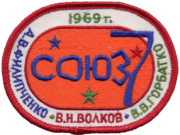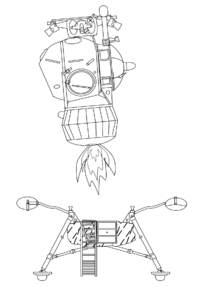Soyuz 7
| Mission type | Test flight | ||||
|---|---|---|---|---|---|
| Operator | Soviet space program | ||||
| COSPAR ID | 1969-086A | ||||
| Mission duration | 4 days, 22 hours, 40 minutes, 23 seconds | ||||
| Orbits completed | 80 | ||||
| Spacecraft properties | |||||
| Spacecraft type | Soyuz 7K-OK(A) | ||||
| Manufacturer | Experimental Design Bureau OKB-1 | ||||
| Launch mass | 6,570 kilograms (14,480 lb) | ||||
| Crew | |||||
| Crew size | 3 | ||||
| Members |
Anatoly Filipchenko Vladislav Volkov Viktor Gorbatko | ||||
| Callsign | Буран (Buran - "Blizzard") | ||||
| Start of mission | |||||
| Launch date | 12 October 1969, 10:44:42 UTC | ||||
| Rocket | Soyuz | ||||
| Launch site | Baikonur 1/5[1] | ||||
| End of mission | |||||
| Landing date | 17 October 1969, 09:25:05 UTC | ||||
| Landing site | 155 kilometres (96 mi) NW of Karaganda | ||||
| Orbital parameters | |||||
| Reference system | Geocentric | ||||
| Regime | Low Earth | ||||
| Perigee | 210 kilometres (130 mi) | ||||
| Apogee | 223 kilometres (139 mi) | ||||
| Inclination | 51.7 degrees | ||||
| Period | 88.8 minutes | ||||

| |||||
Soyuz 7 (Russian: Союз 7, Union 7) was part of a joint mission with Soyuz 6 and Soyuz 8 that saw three Soyuz spacecraft in orbit together at the same time, carrying a total of seven cosmonauts.
The crew consisted of commander Anatoly Filipchenko, flight engineer Vladislav Volkov and research-cosmonaut Viktor Gorbatko, whose mission was to dock with Soyuz 8 and transfer crew, as the Soyuz 4 and Soyuz 5 missions did. Soyuz 6 was to film the operation from nearby.
However, this objective was not achieved due to equipment failures. Soviet sources later claimed that no docking had been intended, but this seems unlikely, given the docking adapters carried by the spacecraft, and the fact that the Soyuz 8 crew were both veterans of the previous successful docking mission. This was the last time that the Soviet manned Moon landing hardware was tested in orbit, and the failure seems to have been one of the final nails in the coffin of the programme.
The radio call sign of the spacecraft was Buran, meaning blizzard, which years later was re-used as the name of the entirely different spaceplane Buran. This word is apparently used as the name of an active or aggressive squadron in Soviet military training, and just like Soyuz 4, the Soyuz 7 spacecraft was constructed to be the active or male spacecraft in its docking.
Crew
| Position | Cosmonaut | |
|---|---|---|
| Commander | Anatoly Filipchenko First spaceflight | |
| Flight Engineer | Vladislav Volkov First spaceflight | |
| Research Engineer | Viktor Gorbatko First spaceflight | |
Backup Crew
| Position | Cosmonaut | |
|---|---|---|
| Commander | Vladimir Shatalov | |
| Flight Engineer | Aleksei Yeliseyev | |
| Research Engineer | Pyotr Kolodin | |
Reserve Crew
| Position | Cosmonaut | |
|---|---|---|
| Commander | Andriyan Nikolayev | |
| Flight Engineer | Georgi Grechko | |
References
- ↑ "Baikonur LC1". Encyclopedia Astronautica. Retrieved 2009-03-04.

